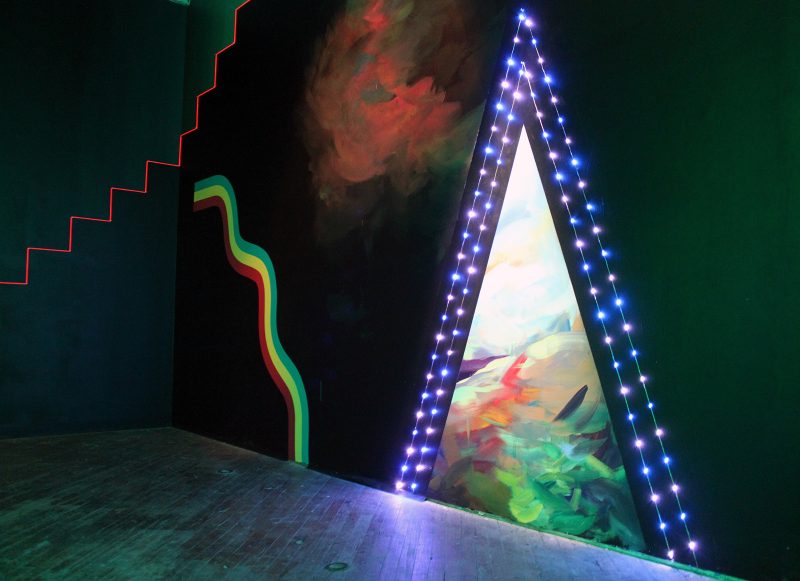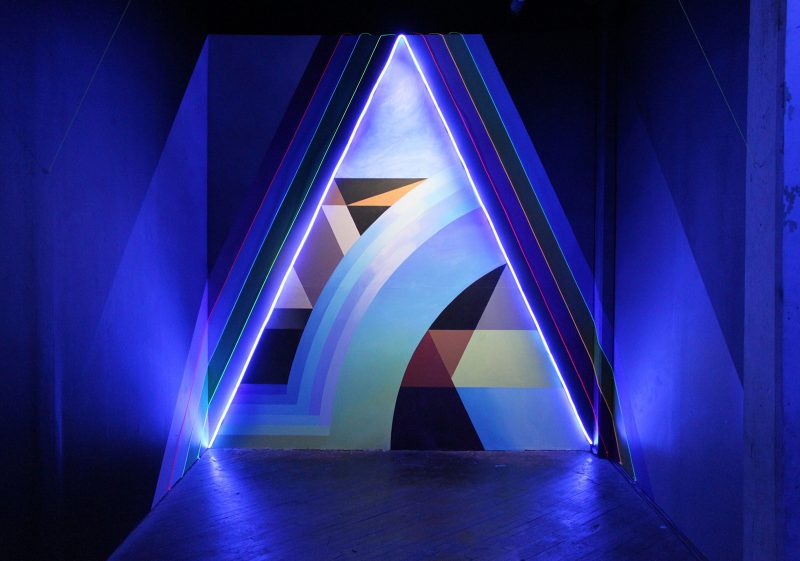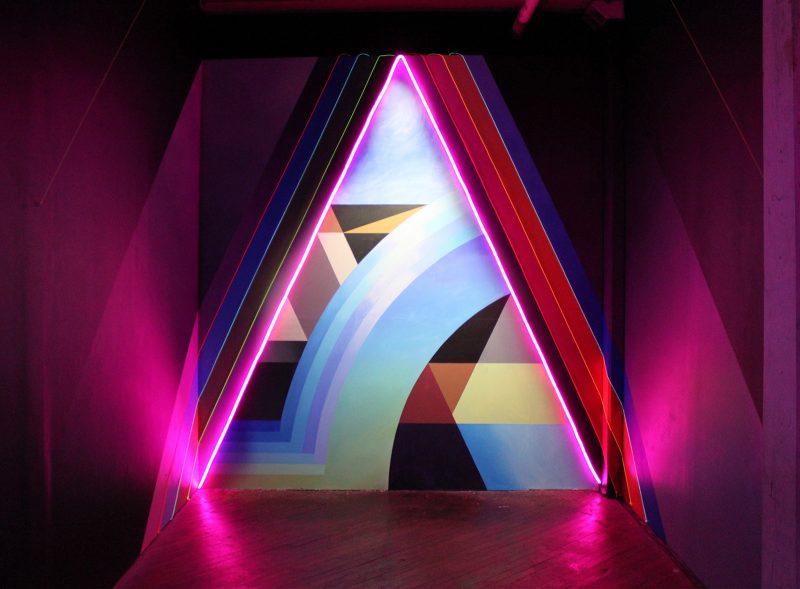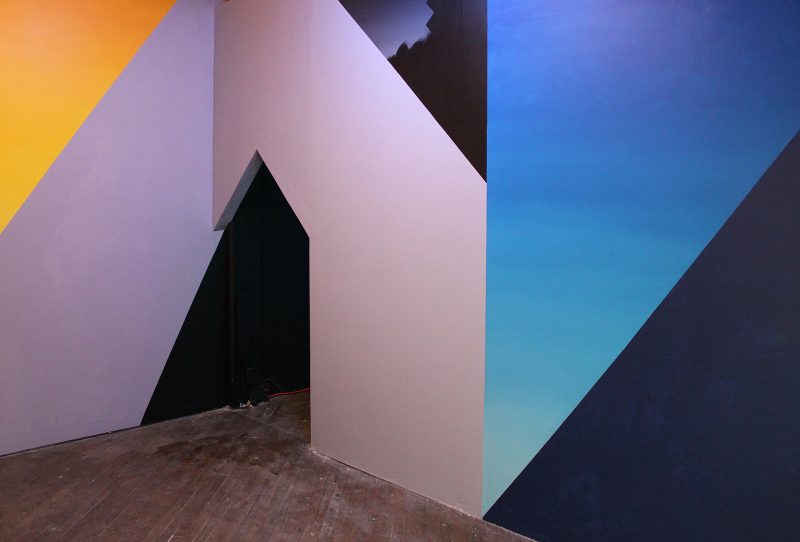
The primal experience of light in darkness
David Guinn’s indoor “son et lumière” installation “Night Room” was inspired by Francis Ford Coppola’s 1979 film Apocalypse Now, and in particular by the film’s primal encounter in a sacred Khmer temple between two soldiers damaged by the war, Kurtz and Willard, each struggling to make sense of the conflict and its horrors.
As Guinn interprets their encounter, Kurtz, the apparently insane vigilante Green Beret (played by Marlon Brando), represents the chaotic inner self, and Willard (played by Martin Sheen), the burned-out soldier sent to assassinate him, the artist. “Night Room”–a dark-painted gallery space with faux painted doors, a spectral lighting system that bathes the room in colors, and a droning soundtrack in the background–is the holy space in which the confrontation takes place. But, unlike in the movie where Kurtz is killed by Willard, Guinn’s “Night Room” is a space where conflict is resolved between inner chaos and the artistic spirit. As Marginal Utility’s David Dempewolf expressed it, “Night Room visualizes a sanctuary space for communion/confrontation with the artistic self.”

Light, sound, and paint
Working with lighting designer Drew Billiau, Guinn’s “Night Room” begins in a field of darkness and, with combinations of wall painting and LED lighting, converts the gallery into a series of gradients, angles, and triangles of captivating, prismatic, evolving color and light, with electric tee pee portals (upside down Maroon 5 Vs) into other realms. As described by Marginal Utility: “Glowing bands of light slowly transition through the spectrum of colors inside the darkened space of the gallery. Wall paintings reference windows and passageways into other environments. Painted gradients transition across sections of the gallery walls.”
Not only does the installation explore the vagaries of light within and beyond darkness, but it invites you into illuminating spaces in which darkness has been converted into or incorporated within dancing fields of colorful abstractions. And in the background plays a deep droning audio which Guinn, together with composer/musician Yanni Papadopoulos, derived from The Doors’ song “The End” (featured in Apocalypse Now) using an electric guitar for melody and a delay pedal, to create a sort of thundering reverb that reminded me of the sound of ominous metal drums in the distance, and which fit the mood of the installation perfectly.

“Night Room” is an immersive experience in which you keep discovering new things, not because of its complexity, but as a result of the purity and simplicity of its components. Its changing perspectives on light and color, together with subtle, unexpected details–some of string, some of light–that you might overlook, are intriguing and satisfying. You find similar purity and simplicity, albeit in a very different form, in Guinn’s wonderful murals.

“Night Room” – the artistic process
I asked Guinn about his view of Apocalypse Now as a story of self-discovery and reconciliation, and his answer related back to his artistic process. “I thought of “Night Room” as the space where the reconciliation happens. Where the ideas and thinking and expectations meet putting the brush to the wall and seeing/accepting what happens. I went into that space and the “Night Room” is what I made. A sanctuary with vistas out into other places/ideas.”
Guinn continued: “There is a mission–an idea. There is a journey into some unknown territory. Along the journey there is an internal struggle–what is this going to be? Am I good enough? Is this what people expect of me? Is this what I want? Through this process there is some discovery and new understanding. With the completion of the piece there is a reconciliation of the internal and external expectations and fears with what ultimately becomes reality.”
Although the exhibit does contemplate light beyond darkness, perhaps light in darkness, I think that the analogy to Apocalypse Now is an imperfect one. The notion of reconciliation in relation to the film or to the Vietnam War does not seem entirely apposite. There never was any way to make sense of the war; there was no sanctuary; no light ever permeated that space in which 58,272 American soldiers died and hundreds of thousands more were crippled, and in which millions of Vietnamese were killed or injured. The war was never legitimate or righteous, and it ripped apart everything in its path.
But if the analogy to the movie and to the war is off, perhaps Guinn’s larger notion is still right. The cauldron of conflict between inner chaos and artistic spirit is not fatal and can be resolved.
Postscript: David Dempewolf mentioned to me that the reaction of visitors to the installation changed after the Presidential election. The aspects of a dark room equate easily with the current mood of dejection and fear, and it is difficult to find light in the darkness. But Guinn’s vision clearly is hopeful, and perhaps we can take from that that this will not be The End.
Night Room will be on display at Marginal Utility through December 11th.










